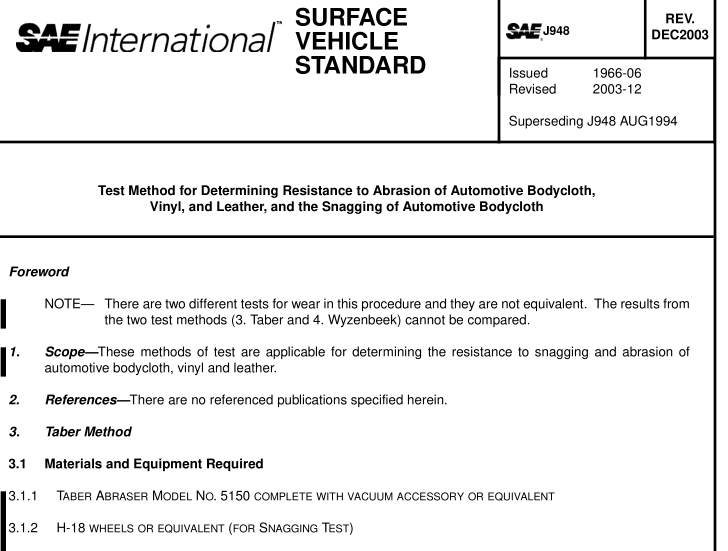SAE J948:2003 pdf download Test Method for Determining Resistance to Abrasion of Automotive Bodycloth, Vinyl, and Leather, and the Snagging of Automotive Bodycloth
3.3 Procedure
a. Mount the refacing disc holder on the Taber Abraser and fasten to the disc holder a piece of S-1 1 type abrasive paper.
b. Adjust test instrument for a 1 000 g load. Loosen the knurled cap nuts and install the new set of wheels on their respective flanged holders as indicated by the printing on the side of the wheel. The one marked right side fits on the right-hand mounting with printed side out; the same with the left. The nut is then replaced and moderately tightened. Check the wheels for alignment. H-1 8 type wheels shall be used when testing snagging resistance and CS-1 0 type wheels shall be used when testing abrasion resistance.
c. Reface abrasive wheels 25 cycles by running them against the S-1 1 type abrasive paper disc mounted on the refacing disc holder. Remove any rough edges on the wheels by manually sanding lightly with the abrasive paper.
d. The wheels must be refaced before each test run to remove abraded materials from the wheels that collected in the prior test.
e. If the wheels are worn out of round, crowned, or excessively clogged with abraded material, they should be dressed using the diamond refacer until the condition is corrected. In cases of doubt about the condition of the abrasive wheels, new wheels shall be used.
f. Dust the refaced abrasive wheels with a small camel’s hair brush and remove the refacing disc holder.
g. With specimen turntable removed from the abraser, place test specimen on the turntable. Adjust the clamping ring to a tight fit over the specimen and holder and press the hold-down ring over the circumference of the holder to pull the test material taut.
h. Remove any wrinkles in the test specimen by adjusting the fabric edges which extend below the clamping ring. Then, tighten the adjusting screw of the ring. Place the washer over the turntable screw and tighten the nut. Trim off the excess test specimen which extends beyond the lower edge of the clamping ring.
i. Lower the abrasive wheels carefully from their upright position to the surface of the test specimen. Set the counter mechanism at zero.
j. Position the vacuum nozzle along the diameter of the turntable 3 mm above the surface of the test specimen and set the vacuum dial in the range of 60 to 70.
k. Turn on the vacuum and start the Taber Abraser. l. Run the specimen the number of cycles specified and remove for evaluation. m. 400 cycles shall be run for snagging unless otherwise specified.
n. 1 000 cycles shall be run for abrasion of bodycloth unless otherwise specified.
4. Wyzenbeek Method—The Wyzenbeek method can be used to determine the resistance to abrasion of automotive vinyl and leather.
4.1 Apparatus and Material Required
4.1 .1 W YZENBEEK W EAR T ESTER OR E QUIVALENT —The hardness of the rubber pads should remain between 55 to 75 when tested with a type “00” durometer on the flat surfaces. Rubber pads which do not fit snugly in their respective holders should be replaced. Due to misalignment or wear during use, the following procedure should be performed when necessary; after cleaning the drum surface with a solvent, insert a piece of 36 grit sandpaper and clamp into position. Lower the arms removing all applied pressure and abrade the rubber pad for 400 cycles or until they conform to the shape of the drum. Clean the resurfaced rubber pad with a stiff brush and re-insert in the same holder and in the same position. Once a rubber pad has been put through this procedure do not use in any other holder without resurfacing.
SAE J948:2003 pdf download
